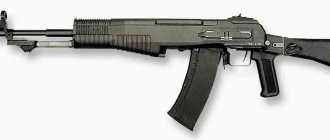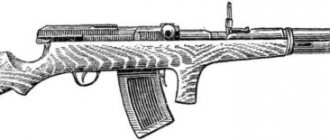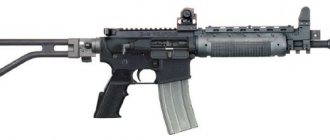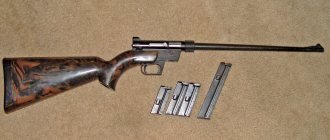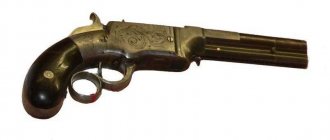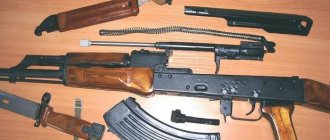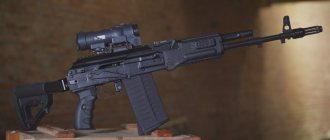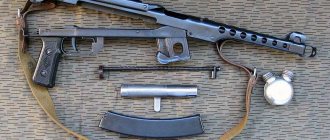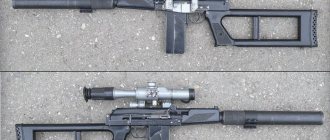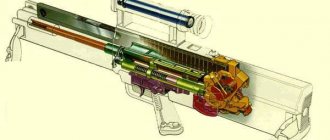"XM8" redirects here. For satellite radio, watch 80's on 8.
* Assault Rifle * Automatic Rifle * Light Machine Gun * Sniper Rifle / Sniper Rifle * Personal Defense Weapon
| XM8 | |
| Early version of XM8 | |
| Type |
|
| Place of origin |
|
| Service history | |
| In service | 2010–present |
| Used | Royal Malaysian Navy |
| Production history | |
| Developed | 2002 |
| Manufacturer |
|
| Produced | 2003–present |
| Options | View options |
| Characteristics | |
| Weight | 3.4 kg (7.5 lb) |
| Length | 840 mm (33 in) |
| Barrel length | 320 mm (12.5 in) |
| Cartridge | 5.56×45mm NATO |
| Action | Burners, butterfly valve |
| Rate of fire | 750 rounds/min |
| starting speed | OK. 900 m/s (view options ) |
| Feeding system | 30-round detachable box magazine, 100-round C-Mag drum magazine |
| Attractions | Reflex sight ISM-V without magnification (4x for the DMR version) |
XM8
is a lightweight assault rifle system from the late 1990s to early 2000s. The rifle was developed by German small arms manufacturer Heckler & Koch (H&K) and shares design and construction with their G36 rifle.
The XM8 design was originally part of the Objective Individual Combat Weapon (OICW) program, which was developing a "smart" grenade launcher system with a sling-mounted carbine rifle. The system did not meet performance and weight requirements and was ultimately cancelled. The two parts of OICW were subsequently split, resulting in the XM8 and XM25 projects.
Although the US Army considered the XM8 as a potential standard-issue infantry rifle to replace the M4 Carbine, the project was suspended in April 2005 and officially canceled on October 31 of that year. The weapon was adopted by the Royal Malaysian Navy for its PASKAL special forces.
History[edit]
| This section requires additional links for verification . |
A US Marine weapons instructor presents the XM8 Carbine during the Main Infantry Operations Symposium in August 2005.
The purpose of the US Army contract for this prototype weapon was to provide replacement options for the M16 rifle after the XM29 program ran into problems. [ clarification needed
] The goal was to create a weapon that was cheaper, lighter and more effective than the M16 and M4 series of weapons. The XM8 is not just one weapon, but a system that can be modified with the appropriate parts to be one of several options from short barreled personal defense weapons to bipod-equipped support weapons. It also included an integrated optical sight and an infrared laser targeting module/illuminator.
The XM8 was based on the rifle module of Alliant Techsystems's XM29 OICW project, of which the weapons mechanisms were H&K's responsibility. After an indefinite delay in the Objective Individual Combat Weapon program, the US Army asked contractors to develop autonomous weapons based on kinetic energy modules and high explosives substances XM29.
The first 30 XM8 prototypes were delivered by November 2003 for preliminary testing. Later, at least 200 prototypes were purchased. Among the complaints during testing were that battery life was too low for a weapon-powered sight system and some ergonomic issues. Two other key issues were reducing the weight of the weapon and improving the heat resistance of the handguard, which began to melt after too many shots. Major testing was largely completed, and the Army was pushing to fund large-scale field testing. However, in 2004, Congress refused to authorize $26 million to purchase 7,000 rifles for large-scale testing of the XM8 in 2005. At the time, the rifle still had unfinished development challenges, primarily related to the weapon's weight; The battery life has been increased and a more heat-resistant plastic handguard has been added. The earliest product brochure states the target weight for the carbine variant is 2.6 kg (5.7 lb), while the current prototype is 2.8 kg (6.2 lb). The prototype carbine's weight has since increased to 3.4 kg (7.5 lb), according to a brochure released by HK and General Dynamics in January 2005.
U.S. Army commanders test fire the XM8 Compact Mount at Fort Benning, Georgia in August 2004.
During the same period, the army came under pressure from other weapons manufacturers [ who?
] to open up the XM8 to competition. The main argument was that the weapon adopted was a significantly different system from the original competition, which ATK and H&K actually won (see XM29). Other issues were that the Army has a legal obligation to give preference to U.S. manufacturers, and that a previous agreement with Colt Defense required the Army to involve Colt in certain small arms programs. The XM8 program was suspended in 2004. The exact reason why this happened is a matter of debate; some combination of the above technical problems, financial constraints and external pressures.
In 2005, the Army issued a formal request for proposals (RFP) for the OICW Increment One family of weapons. This RFP gave manufacturers six months to develop and deliver a prototype weapon with requirements very similar to the XM8's capabilities, but with the addition of a squad automatic weapon (SAW) configuration. No XM8 prototype was shown that truly matched the M249's capabilities (e.g., quick barrel changes, high sustained rate of fire, belt feed). The OICW Increment One requirement for the SAW includes quick barrel changes and a high sustained rate of fire, but leaves the choice of ammunition feed to the discretion of the manufacturer.
Approved funding for the M320 grenade launcher, a single-shot underbarrel grenade launcher similar to the M203 that was originally intended for the XM8. The launcher is heavier than the M203, but has some advantages. [ example needed
] The XM320 was designed for use with existing M16 and M4 inventory and is also compatible with the XM8. It can also be used as a standalone weapon.
Effective July 19, 2005, the OICW Increment One request for proposals was suspended for eight weeks, indicating that the program was being restructured into a joint procurement program. On October 31, 2005, the OICW Increment One RFP was canceled.
In an article in Jane's Defense Weekly
April 26, 2006 (Vol. 43, p. 30) states that "The US Army has again delayed the procurement of its future infantry weapons, this time by more than five years, and is working to field two intermediate weapons in the meantime" .
General Dynamics was involved in the final stages, and H&K had plans to produce the rifle at a plant in Georgia. At the beginning of the project, H&K belonged to Great Britain, but was later bought by a group of German investors. Engineering work was carried out at sites in the USA and Germany.
Cancellation soon[edit]
Prototype XM8 carbine - without PCAP device on the side rails. Also has an open duck-stick type flash hider rather than a birdcage type.
In the fall of 2005, the US military XM8 program was almost canceled after being suspended earlier that year, but was limited to Marine Corps use. If this program had not been specified, the XM8 system would have faced competition from weapons such as the FN SCAR, Bushmaster ACR and HK416. It was later modified and entered as a candidate for the SCAR competition, but was unsuccessful. [1]
Further testing[edit]
In the fall of 2007, the XM8 was compared to other firearms in a "dust test". [2] [ dead link
] The competition was based on two previous tests, which were conducted in the summer of 2006 and the summer of 2007 before the final test in the fall of 2007. In the summer of 2007, M16 rifles and M4 carbines produced a total of 307 results. stops. In the fall 2007 test, the XM8 recorded only 127 stops in 60,000 full rounds while the M4 had 882. [2] The FN SCAR had 226 stops and the HK416 had 233. The difference between the XM8, HK416 and FN SCAR was not statistically significant when adjusted for less reliable STANAG magazine. [3] However, a discrepancy of 575 stops between summer and fall 2007 M4 testing caused officials to explore possible reasons for the change, such as different officials, seasons, and inadequate sample size, but stated that the test conditions were purportedly optimal. same.
XM8 Lightweight Assault Rifle (USA)
Assault rifle (automatic) XM8 in basic configuration (ShotShow-2004 exhibition, January 2004, USA)
Assault rifle (automatic) XM8 in automatic rifle configuration - light machine gun
Assault rifle (automatic) XM8 in the “sharpshooter” configuration (precision shooter, infantry squad level sniper). A spare magazine is attached to the main magazine on the right
Assault rifle (automatic) XM8 in Compact configuration.
The author of the site poses with an XM8 assault rifle at the ShotShow 2004 exhibition.
Caliber
: 5.56x45 mm NATO
Automatic type
: gas operated, locking by rotating the bolt
Length
: 838 mm in the basic configuration, with the butt extended
Barrel length
: 318 mm in the basic version;
229mm in the Compact version and 508mm in the machine gun or sniper rifle version Weight
: 2.59 kg without cartridges
Rate of fire
: 750 rounds per minute
Magazine
: 30 rounds or 100 rounds drum (in the light machine gun version)
In 2002, the American company Alliant Techsystems (ATK), the main developer of the promising XM29 OICW system for the US Army, received a contract to study the possibility of creating a separate assault rifle based on the XM29 “kinetic” subsystem, lighter and more reliable than the current M16A2 rifle and M4A1 carbine . The development itself, under the wise leadership of ATK, was carried out by the American division of the famous German company Heckler-Koch, which also developed the XM29 OICW system. The promising rifle should provide a 20% saving in weapon weight compared to the M16A2 and M4, which, in combination with the 5.56mm cartridges with a lightweight composite metal-plastic sleeve being developed and currently being developed, can literally make the life of future infantrymen of the US Armed Forces easier. The launch of the new rifle into mass production was scheduled for 2005, while the XM29 project is currently frozen.
In mid-2005, the first mass deliveries of the XM8 system to US Army units were supposed to begin. However, due to complaints from a number of companies also vying for their piece of the fat army pie, the US Congress “appeared” to the Army to attempt to put the XM8 system into service without a mandatory competition. In July 2005, the Army officially released the terms of competition for the new modular small arms system OICW Increment 1; It was assumed that the selection of participants for competitive tests would be completed in November 2005. However, closer to the fall of 2005, the US Army officially announced the suspension of this competition until the full set of requirements was clarified, which would now have to include the wishes of not only the army, but also other branches of the US Armed Forces. In addition, information appeared on the network that the HK XM8 rifles revealed some problems during their extended testing. As a result, the program to create the XM8 assault rifle died, and since 2006 no more work has been carried out on it.
Technical description. In terms of automation, the XM8 modular rifle is practically no different from the German Heckler-Koch G36 rifle, on the basis of which it was created. XM8 has the same automation scheme with a short stroke of the gas piston located above the barrel, and locking the barrel by turning the bolt, which has 7 lugs. The receiver, forend, and butt are made of high-strength plastic.
XM8 barrels are quick-change; it is assumed that, depending on the desired configuration, the following types of barrels will be used: 318 mm long in the basic version; length 229 mm in Compact / PDW version; 508 mm in the sniper rifle version and 508 mm weighted in the Automatic Rifle version, that is, a light machine gun. The buttstocks are also easily replaceable; the main one is the five-position telescopic buttstock, which is adjustable in length. Instead of a standard forend, it is possible to install a 40mm single-shot XM320 grenade launcher (modified Heckler-Koch AG36 grenade launcher) with a standard barrel, or a forend with an integrated bipod with a machine gun barrel. The carrying handle is also removable and has mounts for various sights. The main sight is supposed to be a red dot sight with a battery-powered illuminator; it is also possible to install various other sights.
Two-way translator - the safety is located above the pistol grip and ensures firing in single shots and bursts; fire with a cut-off burst of 2 or 3 shots is not planned. The bolt handle is located above the receiver, similar to the G36, and is accessible to both hands. The cartridges are fed from detachable box magazines with 30 rounds of ammunition or, in the machine gun version, also from 100-round drum magazines.
Design[edit]
XM8 testing; One marksman kneels with an XM8 carbine and XM320 (40mm grenade launcher) attached to him, while the other uses the XM8 sniper variant (designated the marksman).
A variant of the XM8 compact carbine with an attached stock issued by a US Army weapons tester.
The XM8 is a 5.56mm selective fire assault rifle fired from a closed bolt action. Its design and operation are similar to the Heckler & Koch G36 assault rifle, from which it is derived.
Materials and weight[edit]
The materials used to construct the XM8 are almost entirely composites, with the exception of the cold forged steel barrel. Preliminary testing in desert and arctic conditions has shown the XM8 to be a reliable weapon, although there have been some complaints. [ clarification needed
]
Most of the expected cost and weight savings come from the weapon's electronic sighting. The basic XM8 carbine (with integrated scope), for example, can be compared to an M4 carbine with a variety of previous generation electronic add-ons such as AN/PEQ-2, Aimpoint CompM2, Advanced Combat Optical Gunsight and/or BUIS. Without the benefit of the next-generation electronic sight combination, the XM8 would be heavier and more expensive than the firearm it was intended to replace.
Accessories [edit]
The XM8 abandoned the standard Picatinny rail for mounting weapon accessories in favor of a new standard called PCAP ( P
icatinny
C
ombat
A
ttachment
P
oints), small oval holes on the front handle. (A variant was designed with MIL-STD-1913 - XM8 R rails; and some early XM8 prototypes had rails.) PCAP is not backward compatible with currently used attachments that use MIL-STD-1913 rails without the use of an adapter. However, the advantage of PCAP is the precision of the connection between the accessory and the body of the weapon; Accessories using Picatinny rails often need adjustment when removed and reattached. Additionally, the XM8 comes with most of the standard extra features built into it. Where functionality was missing, accessories were expected to be redesigned to use PCAP. In the new OICW Increment One competition, the Army awarded the choice of attachment technology to the manufacturer, with requirements built into the RFP regarding the ability of the sights to maintain zero level.
The M4 Carbine has a 368 mm (14.5 in) barrel and the XM8 has a 317 mm (12.5 in) barrel, but the rifles are the same overall length. Although a shorter barrel generally results in a lower muzzle velocity, polygonal rifling partially compensates for the loss of velocity due to a shorter barrel. An electronic projectile counter was proposed for the XM8. The system tracked the number of shots fired and the date and time of each shot. The data will then be accessed wirelessly using a device such as a PDA. Another benefit would be tracking unauthorized weapon use or confirming field reports. Other features included fully ambidextrous controls and a built-in red dot/3x optical zoom sight (later changed to a 1x red dot/sight). However, the designated shooter configuration used a 3.5x scope.
Excerpt describing HK XM8
It was not a ball, and it was not said that there would be dancing;
but everyone knew that Katerina Petrovna would play waltzes and ecosaises on the clavichord and that they would dance, and everyone, counting on this, gathered at the ballroom. Provincial life in 1812 was exactly the same as always, with the only difference that the city was livelier on the occasion of the arrival of many wealthy families from Moscow and that, as in everything that happened at that time in Russia, it was noticeable some kind of special sweepingness - the sea is knee-deep, the grass is dry in life, and even in the fact that that vulgar conversation that is necessary between people and which was previously conducted about the weather and about mutual acquaintances, was now conducted about Moscow, about the army and Napoleon. The society gathered from the governor was the best society in Voronezh. There were a lot of ladies, there were several of Nikolai’s Moscow acquaintances; but there were no men who could in any way compete with the Cavalier of St. George, the repairman hussar, and at the same time the good-natured and well-mannered Count Rostov. Among the men was one captured Italian - an officer of the French army, and Nikolai felt that the presence of this prisoner further elevated the importance of him - the Russian hero. It was like a trophy. Nikolai felt this, and it seemed to him that everyone was looking at the Italian in the same way, and Nikolai treated this officer with dignity and restraint. As soon as Nicholas entered in his hussar uniform, spreading the smell of perfume and wine around him, he himself said and heard the words spoken to him several times: vaut mieux tard que jamais, they surrounded him; all eyes turned to him, and he immediately felt that he had entered into the position of everyone’s favorite that was due to him in the province and was always pleasant, but now, after a long deprivation, the position of everyone’s favorite intoxicated him with pleasure. Not only at stations, inns and in the landowner’s carpet were there maidservants who were flattered by his attention; but here, at the governor’s evening, there was (as it seemed to Nikolai) an inexhaustible number of young ladies and pretty girls who were impatiently waiting for Nikolai to pay attention to them. Ladies and girls flirted with him, and from the first day the old women were already busy trying to get this young rake of a hussar to marry and settle down. Among these latter was the governor’s wife herself, who accepted Rostov as a close relative and called him “Nicolas” and “you.” Katerina Petrovna really began to play waltzes and ecosaises, and dances began, in which Nikolai even more captivated the entire provincial society with his dexterity. He surprised even everyone with his special, cheeky style of dancing. Nikolai himself was somewhat surprised by his manner of dancing that evening. He had never danced like that in Moscow and would even have considered such an overly cheeky manner of dancing indecent and mauvais genre [bad taste]; but here he felt the need to surprise them all with something unusual, something that they should have accepted as ordinary in the capitals, but still unknown to them in the provinces. Throughout the evening, Nikolai paid most of his attention to the blue-eyed, plump and pretty blonde, the wife of one of the provincial officials. With that naive conviction of cheerful young people that other people's wives were created for them, Rostov did not leave this lady and treated her husband in a friendly, somewhat conspiratorial manner, as if they, although they did not say it, knew how nicely they would get together - then there is Nikolai and this husband’s wife. The husband, however, did not seem to share this conviction and tried to treat Rostov gloomily. But Nikolai’s good-natured naivety was so boundless that sometimes the husband involuntarily succumbed to Nikolai’s cheerful mood of spirit. Towards the end of the evening, however, as the wife's face became more ruddy and livelier, her husband's face became sadder and paler, as if the share of animation was the same in both, and as it increased in the wife, it decreased in the husband . Source - ""
Categories:
- Weapons in alphabetical order
- German machine guns
- Canceled American weapons projects
- Heckler & Koch
- Alliant Techsystems Military Products
Hidden categories:
- Pages using duplicate arguments in template calls
- Articles with links to missing files
- Wikipedia: Articles with value overrides from Wikidata
- Unfinished articles about the machine
Options [edit]
PASKAL Navy operators standby during the Malaysian 57th National Day Parade.
H&K XM8 carbine mounted on the H&K AG36 underbarrel grenade launcher of the Royal Malaysian Navy PASKAL special forces.
Throughout most of its service life, four different models were offered: a compact PDW (personal defensive weapon) with a 241 mm (9.5 in) barrel, a carbine with a 317 mm (12.5 in) barrel, a sniper and an automatic rifle variant, both. with 508 mm (20 inch) barrels. An additional 100-round Beta C-Mag twin-cylinder light machine gun is available. Accessories such as optical sights, a grenade launcher, and a bipod were integrated using a new system that allows for precise mounting (so that, for example, the sights do not have to be readjusted every time they are attached). Like the M4 and M16, the XM8 was chambered in 5.56×45mm NATO and was typically equipped with a 30-round plastic box magazine also used in the G36. Although this meant that the magazine body was not compatible with the STANAG M4 and M16 metal magazine without the use of an adapter. A 100-round Beta C-Mag magazine with two drums could also be used.
One of the unique features of the XM8 was its modularity. In addition to the adaptations mentioned above, this modularity allowed for quick repairs, changes in barrel length and even caliber in the field. Beyond the core components, the XM8 would complement the XM29 with features such as identical accessory mounts.
The number and types of variants in the family varied throughout its lifespan, this overview of the three main versions is based on a press release in the early 2000s.
- XM8 Compact Carbine: 229 mm (9 in) barrel, PDW configuration, folding stock [4] or stock; muzzle velocity 720 m/s (2,362 ft/s)
- XM8 carbine with XM320 grenade launcher: 317 mm (12.5 in) barrel; muzzle velocity 815 m/s (2,674 ft/s)
- Automatic rifle: 508 mm (20 in) barrel, muzzle velocity 916 m/s (3,005 ft/s)
- Special sniper rifle: 508 mm (20 in) barrel, built-in folding bipod, 4x scope, 30/100 round magazine; muzzle velocity 916 m/s (3,005 ft/s) s [5]
- Light machine gun: 508 mm (20 in) heavy barrel with built-in folding bipod, rate of fire 600-750 rpm.
Usage[edit]
While the XM8 fell out of favor with the US military, Heckler & Koch sought to sell the rifle worldwide. Meanwhile, the Malaysian Armed Forces expressed interest in using the rifle and by 2007 had openly stated their intention to acquire the XM8 rifle. By 2010, the Royal Malaysian Navy Special Forces PASKAL began using the XM8 along with other Heckler & Koch assault rifles including the HK416 and G36. [6] [ verification required
]
Specifications
- Caliber: 5.56×45 (.223 Remington)
- Weapon length: 840 mm
- Barrel length: 318 mm
- Weight without cartridges: 2.6 kg.
- Rate of fire: 750 rounds/min
- Magazine capacity: 30 rounds
Assault rifles
- Austria
- Brazil
- Czech
- South Korea
- South Africa
- France
- USA
- Singapore
- Spain
- Russia/USSR
- Australia
- Finland
- Germany
- Türkiye
- Switzerland
- Denmark
- Japan
- Israel
- Sweden
- Indonesia
- Belgium
- Poland
- Ukraine
- Italy
- Croatia
- Iran
- Dominican Republic
- Mexico
- Serbia
- Argentina
- China
- Canada
- Taiwan
- Great Britain
Links[edit]
- "Army agrees to M4 Sand Test firefight". Military.com. Retrieved September 8, 2008.
- ^ ab Cox, Matthew (2001-12-17). "New carbines beat M4 in dust test". Army Times
. Retrieved July 20, 2011. - "New Carbines Beat M4 in Dust Test - Army News, Opinions, Editorials, Iraq News, Photos, Reports - Army Times". armytimes.com. Retrieved September 8, 2008.[ permanent dead link
] - https://www.thefirearmblog.com/blog/2018/01/26/potd-unicorns-exist-hk-xm8-compact-pdw/
- "" XM-8 Combat Rifle "at military.com". Retrieved September 28, 2010.
- Wangguang, Lei (2015-03-21). "Langkawi Airshow / PASCAL─ Sea Dragon Special Fighting / 蘭卡威航展 /PASCAL─大馬海中特戰蛟龍". Youth Daily News
(in Chinese). Archived from the original on 2016-01-07. Retrieved April 20, 2015.
